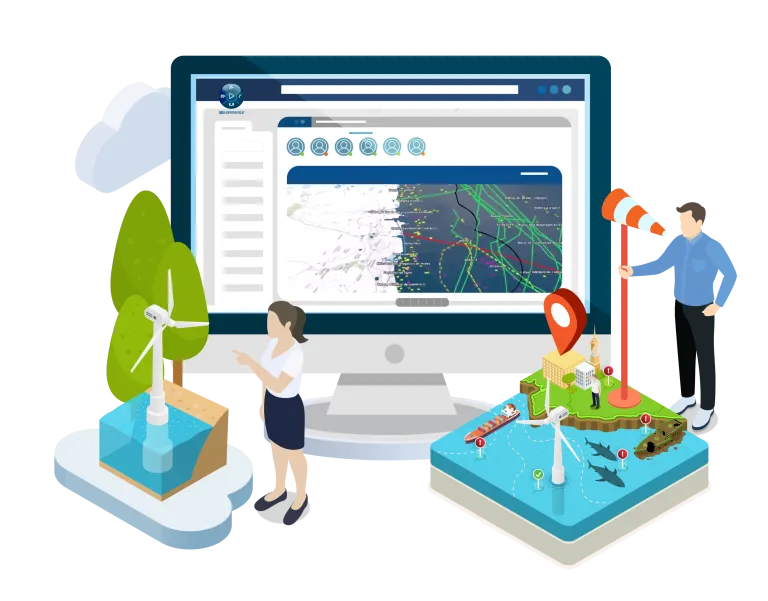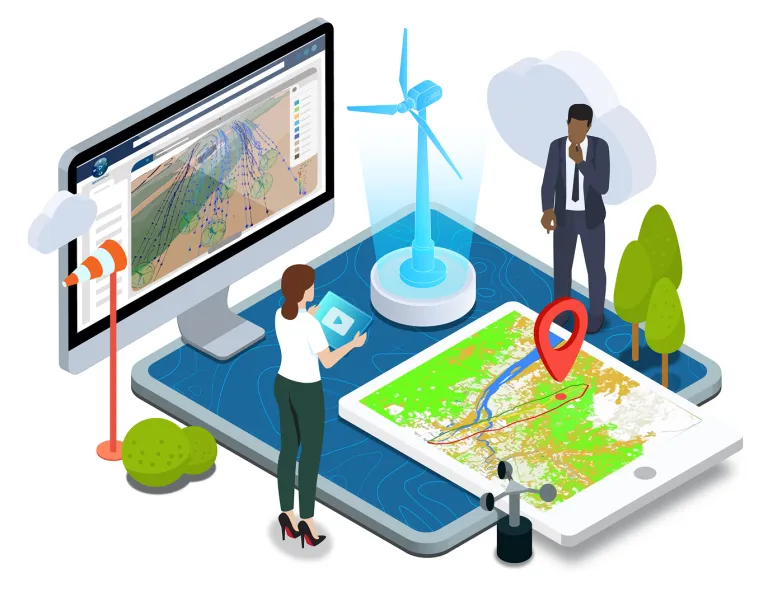Geospatial Insights for Renewable Energy Infrastructure Project
Transform how energy infrastructure is planned using geospatial technology and team collaboration to improve sustainability.
What is Geospatial Insights in Energy Infrastructure?
Geospatial insights in energy infrastructure involve the use of location-based data to enhance the planning and management of energy generation systems. By integrating key information such as environmental conditions, topography and infrastructure layouts, these insights support smarter decision-making, helping to optimize energy projects and ensure they meet efficiency and sustainability goals.
Empower Your Energy Projects with Geospatial Insights
Renewable energy infrastructure projects demand meticulous planning to optimize energy efficiency while minimizing environmental impact. Through its geospatial solution, GEOVIA empowers you to bring together a range of critical information, including the following aspects. This comprehensive approach ensures a clear understanding of the project's context.
Physical & Environmental Data
Includes topography, wind speed, soil properties, water resources and protected ecological or environmental zones.
Infrastructure & Accessibility Data
This covers information on road access, power grids, residential areas and transportation infrastructure.
Regulatory & Legal Data
Includes information on permitted construction areas, legal restrictions and local or international environmental and urban planning regulations.
Collaborate on Large-Scale Projects Without Compromising Data Security
GEOVIA's solution based on the 3DEXPERIENCE platform also facilitates collaboration for consortiums of companies by providing a secure and efficient way to share critical information while protecting sensitive data. Companies collaborating on large-scale projects can seamlessly integrate crucial data, such as technical and engineering specifications, environmental assessments and regulatory compliance requirements, ensuring alignment and informed decision-making.
At the same time, the platform provides strong privacy controls, allowing organizations to safeguard proprietary or confidential information, ensuring that only authorized parties have access to sensitive data. This delicate balance between collaboration and confidentiality builds trust among partners and contributes to the long-term success of joint ventures.
Key Benefits of Geospatial Solutions for Energy Infrastructure Projects
Transforming Wind Farm Planning with Geospatial Analysis
The successful integration of a wind energy project into its physical and social environment relies on a precise assessment of site constraints and opportunities. Geospatial data plays a crucial role in this analysis, enabling not only a better understanding of the project's environmental impact but also promoting informed decision-making. It helps identify suitable areas, assess risks and improve communication with stakeholders, including local communities and authorities.
Webinar: Digital Twin for Energy Infrastructure Projects
Harnessing the Power of Geospatial Data
Watch the on-demand replay of an exclusive webinar with Fabrice Servant, Customer Success Director at GEOVIA and Stefan Ceulemans, IE&M Business Value Consultant, as they explore the latest advancements in energy infrastructure project management. This session demonstrates how georeferenced virtual twins offer a comprehensive, data-driven solution to optimize project planning, development and operations. You’ll gain valuable insights into best practices for effective collaboration across stakeholders using a centralized platform, learn how to build accurate digital models of your energy infrastructure by integrating geospatial data and discover how to make informed, strategic decisions through advanced data visualization and analysis.
Energy Infrastructure FAQs
Also Discover
Learn What GEOVIA Can Do for You
Speak with a GEOVIA expert to learn how our solutions enable seamless collaboration and sustainable innovation at organizations of every size.
Get Started
Courses and classes are available for students, academia, professionals and companies. Find the right GEOVIA training for you.
Get Help
Find information on software & hardware certification, software downloads, user documentation, support contact and services offering





